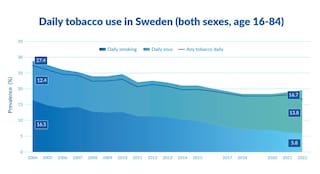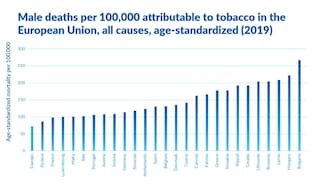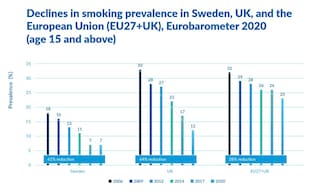Public health data show that rates of smoking prevalence and smoking-related diseases are significantly lower in Sweden than across the rest of the European Union.1
A critical reason for this difference is the large number of Swedes who have switched from smoking to snus—an oral smokeless tobacco product placed between the lip and gums.
In 1992, when the EU banned this far less harmful smoke-free alternative to cigarettes, Sweden retained an exemption from this ban. This was in keeping with the country’s historical support for this nicotine-containing better alternative, which has seen significant use among Swedish men since the 1970s.
This forward-thinking approach has allowed Sweden to achieve one of the lowest smoking rates in the developed world.2 Public health data reveal that the number of daily smokers in Sweden dropped from 16.5 percent in 2004 to 5.8 percent in 2022, while the number of daily snus users has remained relatively steady.3
Sweden’s progress puts it less than 1 percent away from achieving “smoke-free” status—which, like the targets set by most governments across the world, requires the country to achieve a smoking prevalence rate below 5 percent.
Meanwhile, according to third-party research, the number of deaths attributable to tobacco use among Swedish men in 2019 (see chart below) suggests a link between the adoption of tobacco harm reduction measures and improved outcomes for public health.
This research reveals that Swedish men—who began switching from smoking to snus much earlier than Swedish women—have the lowest tobacco-related mortality rates among males in the EU, with 72 deaths per 100,000 attributed to tobacco use in 2019.4
The Swedish Snus Commission estimates that 355,000 smoking-attributable deaths among men over 30 could have been avoided per year if the other EU countries had matched Sweden’s tobacco-related mortality rate.5
So, could Sweden’s diminishing smoking rate be due to stricter smoking control measures? It appears not, as this country’s cigarette regulations—which include minimum age limits, marketing restrictions, prominent health warnings, a ban on characterizing flavors, and indoor smoking bans—are broadly similar to those adopted by the rest of the EU.
The only notable difference between Sweden and other EU nations on tobacco control is its long-term acceptance of snus. This underscores the importance of tobacco harm reduction in helping adults who don’t quit tobacco and nicotine entirely to switch to a better alternative to continued smoking.
A study by Eurobarometer supports this finding. It shows a striking decline in smoking rates in Sweden and the U.K. between 2006 and 2020 versus a much slower decline in the EU overall.6 Compared with the EU nations (excluding Sweden), the U.K. is more supportive of smoking alternatives, notably e-cigarettes.
It’s important to note that if Sweden and the U.K. were removed from the EU data pool, smoking percentage rates for the region would be higher—and, hence, the gap even wider.
Of course, the best choice any smoker can make is to quit all forms of nicotine and tobacco consumption. But we know, in any given year, more than 9 out of 10 smokers will likely continue to smoke.
The cases of countries like Sweden and Japan provide clear evidence that smoke-free alternatives can complement existing tobacco control measures to reduce smoking rates—and potentially smoking-attributable diseases—faster than traditional measures alone.
The sooner other countries act, the better the outlook for global population health.
1Harm reduction in nicotine addiction: helping people who can't quit – RCP London, Mortality attributable to tobacco among men in Sweden and other European countries: an analysis of data in a WHO report | Tobacco Induced Diseases | Full Text (biomedcentral.com), and v012p00349.pdf (nih.gov)
2
Smoking among adults | Health at a Glance: Europe 2022: State of Health in the EU Cycle | OECD iLibrary (oecd-ilibrary.org)
3
Användning av tobaks- och nikotinprodukter (självrapporterat) efter ålder, kön och år. Andel (procent).. PxWeb (folkhalsomyndigheten.se)
4
https://gfn.events/new-research/lars-m-ramstrom-2022/
5
Snuskommissionen_rapport3_eng_PRINT.pdf (snusforumet.se)
6
Attitudes of Europeans towards tobacco and electronic cigarettes, February 2021, Eurobarometer survey (europa.eu)






